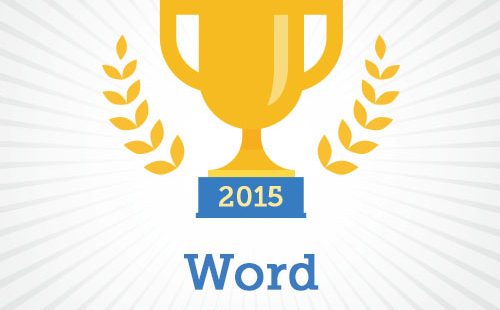In 2015, Dictionary.com saw a number of themes emerge in the words that gained enough traction to be added to the dictionary along with words that trended in user lookups. The most prominent theme across both of these areas was in the expanding and increasingly fluid nature of conversations about gender and sexuality. Additionally, the theme of racial identity led to some of the most notable headlines and new additions to Dictionary.com this year. Encapsulating the most robust fields of language evolution and user interest this year, Dictionary.com’s 2015 Word of the Year is identity.
Identity and gender
Dictionary.com has updated a handful of terms to reflect the new ways that people are speaking about the concept of identity explicitly. These include a new sense at the word identify to account for the common construction identify as and the addition of the term gender expression, defined as “the external expression of gender roles, as through socially defined behaviors and ways of dressing.” Further edits were made to the entry code-switching. Originally a linguistic term, code-switching has expanded in meaning in the recent past to encompass all aspects of identity beyond just language or manner of speech. The sociolinguistic definition is “the use of one dialect, register, accent, or language variety over another to project a specific identity.” The less technical sense is “the modifying of one’s behavior, appearance, etc., to adapt to different sociocultural norms.” Over the last few years, code-switching has emerged as important terminology for framing our multi-faceted identities.
This year was marked with high-profile events that shaped the cultural conversation around gender identity. In January, Transparent, a scripted series about the patriarch of a family coming out as a trans woman, won the Golden Globe for Best Television Series; in June, Caitlyn Jenner appeared on the cover of Vanity Fair, and in July the Pentagon announced its decision to allow transgender people to serve openly in the military. Conversations around whether transgender students should be allowed to attend all-women’s colleges came to a head with new policies introduced by schools including Smith, Barnard, and Wellesley, which officially opened admission to trans women for the first time this year.
Identity and changing language
As new paradigms of gender and sexual identity enter the mainstream, so, too, do new linguistic constructs to discuss them. Increased awareness and openness in discussing gender identity ushers in language-related questions: What is a person’s preferred pronoun? Is it grammatical to use they to refer to a person who falls outside the gender binary? What honorific do you use to show respect to a person who doesn’t identify as Mr., Mrs., Miss, or Ms.? Dictionary.com added a handful of terms throughout the year that reflect this shifting landscape, including the adjectives agender, bigender, gender-fluid, and the gender-neutral prefix Mx. Additionally, we saw lookups for transgender and cisgender surge throughout the year.
The US Supreme Court’s historic ruling in June that same-sex marriage is a constitutional right provided an important benchmark in the evolution of the word marriage. As the term has grown to become more inclusive, Dictionary.com has closely tracked these shifts and its associated definition. Many of the related words that we use to talk about marriage, such as husband, wife, partner, fiancé(e), have experienced nuanced meaning shifts over the last several years in light of both same-sex marriages and increased awareness of nonbinary gender roles.
Celebrities and films propelled terms around sexual identity into the spotlight this year, causing a wave of interest on Dictionary.com: in the days following Miley Cyrus’s acknowledgement in Elle that she identifies as pansexual, we saw lookups for that term soar. The February premiere of the movie Fifty Shades of Grey contributed to a sustained interest in related words on Dictionary.com, but lookups spiked for terms beyond those launched into popular culture by Christian Grey: demisexual, omnisexual, and asexual all trended in lookups this year. Dictionary.com added the word sapiosexual this year, defined as “a person who finds intelligence to be a sexually attractive quality in others.”
Racial identity in 2015
Beyond gender and sexuality, the theme of racial identity was much discussed in 2015. A little over a week before the US Supreme Court’s ruling on same-sex marriage, the nation was absorbed in the story of Rachel Dolezal, a white woman presenting herself as a black woman. She had been serving as an NAACP chapter president, and she told the press that she had been identified as biracial or transracial throughout her life. This sparked a wave of debate on social media and in news outlets, with some inviting comparisons between racial identity and gender identity.
Also this year, developments in nonverbal communication engendered conversations about identity. For the first time, the Unicode Consortium allowed users to text emoji in a wide spectrum of skin and hair color. Before 2015, faces and hand-signal emoji, for the most part, fell into the limiting scope of one-race-fits-all.
This past May, Dictionary.com added the term microaggression, meaning “a subtle but offensive comment or action directed at a minority or other nondominant group that is often unintentional or unconsciously reinforces a stereotype.” The term microaggression was used by some outlets to describe an incident in which Anthony Horowitz, the author of the latest James Bond book, called actor Idris Elba “too street” to play James Bond.
As captured in the title of a New York Times Magazine article from October, 2015 was “The Year We Obsessed Over Identity.” Wesley Morris observes, “Gender roles are merging. Races are being shed. In the last six years or so, but especially in 2015, we’ve been made to see how trans and bi and poly-ambi-omni- we are.” This rings true on both a cultural level and on a linguistic level. No doubt, terms relating to identity will continue to be a theme that lexicographers at Dictionary.com closely monitor in 2016.












